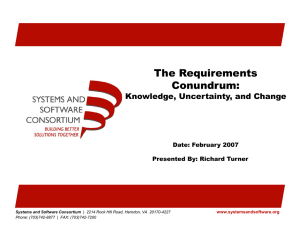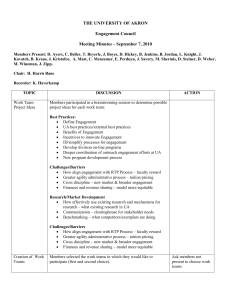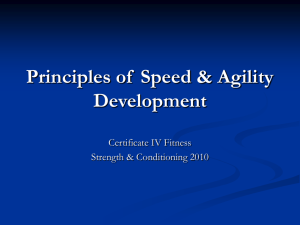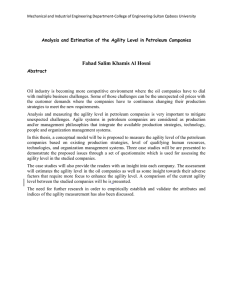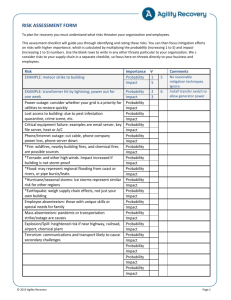19 Program Design and Technique for Speed and Agility Training
advertisement
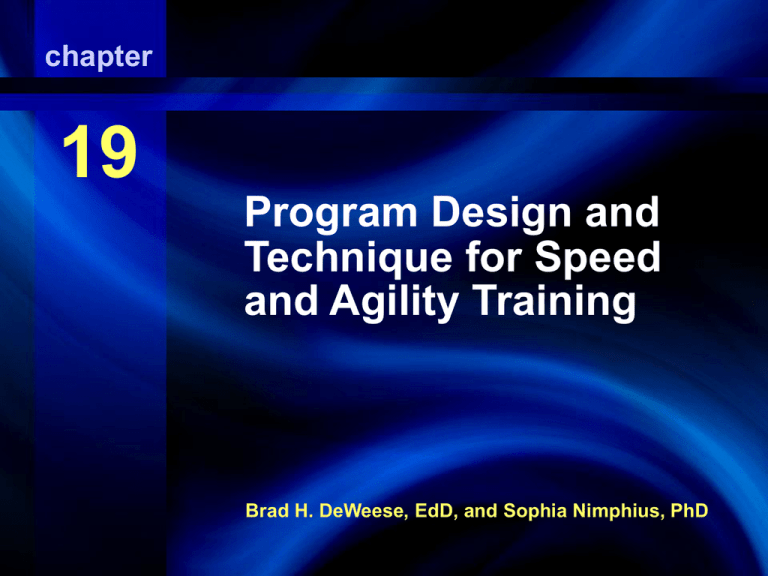
chapter Agility, and Speed-Endurance Speed, Development 19 Program Design and Technique for Speed and Agility Training Brad H. DeWeese, EdD, and Sophia Nimphius, PhD Chapter Objectives • Describe the underlying biomechanical constructs of sprint, change-of-direction, and agility performance • Apply sound movement principles to the coaching of locomotion modes and techniques • Analyze the abilities and skills needed to perform specific movement tasks (continued) Chapter Objectives (continued) • Effectively monitor the development of sprint, change-of-direction, and agility abilities • Apply sounds means and methods for developing speed, change of direction, and agility • Design and implement training programs to maximize athletic performance Key Terms • speed: The skills and abilities needed to achieve high movement velocities. • change of direction: The skills and abilities needed to explosively change movement direction, velocities, or modes. • agility: The skills and abilities needed to change direction, velocity, or mode in response to a stimulus. Key Point • Speed requires the ability to accelerate and reach maximal velocity, whereas agility performance requires the use of perceptual–cognitive ability in combination with the ability to decelerate and then reaccelerate in an intended direction. Speed and Agility Mechanics • In order to execute movement techniques, athletes must skillfully apply force. Due to limited time to produce force during athletic activities, there are two variables that describe force relative to the time available to produce force: rate of force development (RFD) and impulse. (continued) Speed and Agility Mechanics (continued) • Impulse – Impulse is the change in momentum resulting from a force, measured as the product of force and time. – A basic objective of training is to move the force– time curve up and to the left, generating greater impulse and momentum during the limited time over which force is applied. • Rate of force development – The development of maximal force in minimal time, typically used as an index of explosive strength. (continued) Speed and Agility Mechanics (continued) • Physics of sprinting, change of direction, and agility – Force represents the interaction of two physical objects. – Acceleration is the change in an object’s velocity due to movement of mass. – Velocity describes both how fast an object is traveling and in what direction. (continued) Speed and Agility Mechanics (continued) • Impulse – Figure 19.2 (next slides) • Sprint ground reaction force and impulse (a) The acceleration phase (b) The maximal velocity phase Figure 19.2(a) Figure 19.2(b) Speed and Agility Mechanics • Practical implications for change of direction and agility – In addition to the requirement for acceleration, the production of braking forces over certain periods of time, termed braking impulse, should be considered during change-of-direction and agility maneuvers. Neurophysiological Basis for Speed • Nervous system – Increases in neural drive, which are indicative of an increase in the rate at which action potentials occur, are related to increases in both muscular force production and the rate of force production. – Taken together, increases in neural drive may contribute to increases in the athlete’s RFD and impulse generation. (continued) Key Term • Stretch–shortening cycle (SSC): An eccentric–concentric coupling phenomenon in which muscle–tendon complexes are rapidly and forcibly lengthened, or stretch loaded, and immediately shortened in a reactive or elastic manner. Neurophysiological Basis for Speed • Stretch–shortening cycle – SSC actions exploit two phenomena: • Intrinsic muscle–tendon behavior • Force and length reflex feedback to the nervous system. – Acutely, SSC actions tend to increase mechanical efficiency and impulse via elastic energy recovery. – Chronically, they upregulate muscle stiffness and enhance neuromuscular activation. (continued) Neurophysiological Basis for Speed (continued) • Spring–mass model – A mathematical model that depicts sprinting as a type of human locomotion in which the displacement of a body mass is the aftereffect from energy produced and is delivered through the collective coiling and extension of spring-like actions within muscle architecture (continued) Neurophysiological Basis for Speed (continued) • Figure 19.3 (next slides) – A simple spring–mass model relative to the ground reaction force during the stance phase of a sprint – During the stance phase, the model demonstrates how the leg (represented as a spring) is uncompressed at initial contact and then is compressed (represented by the change in length of the spring) during midstance or as vertical ground reaction force increases Figure 19.3(a) Figure 19.3(b) Key Point • As sprinting requires an athlete to move at high speeds, strength and conditioning professionals should emphasize the prescription of exercises that have been shown to increase neural drive while overloading musculature of the hip and knee regions involved in the SSC. Neurophysiological Basis for Speed • Figure 19.4 (next slide) – Plant phase of a change-of-direction movement • This is the point in a change-of-direction movement that represents the transition between the deceleration step and the acceleration step. • Body positioning and the ability to maintain strong trunk positions during the deceleration of momentum and reorientation of the body to run in a new direction are critical for performance. Figure 19.4 Running Speed • Sprinting is a series of coupled flight and support phases, known as strides, orchestrated in an attempt to displace the athlete’s body down the track at maximal acceleration or velocity, usually for brief distances. Key Point • Sprint speed is determined by an athlete’s stride length and stride rate; more successful sprinters tend to have longer stride lengths as a result of properly directed forces into the ground while also demonstrating a more frequent stride rate. These findings suggest that RFD and proper biomechanics are two of the primary limiting factors influencing sprint performance. Stride Length, Stride Frequency • Figure 19.5 (next slide) – Stride length–frequency interaction as a function of running velocity Figure 19.5 Running Speed • Figure 19.6 (next slides) – (a) Stride length, (b) stride frequency, and (c) running velocity in 100 m sprinters of varying qualifications • Elite male sprinters achieve a stride length of 2.70 m, whereas novice sprinters display a stride length of 2.56 m at maximum velocity (figure 19.6a). • Elite male sprinters demonstrate stride rates near 4.63 steps per second compared to novice sprinters, who produce a lesser stride rate of 4.43 steps per second (figure 19.6b). Figure 19.6(a) Reprinted, by permission, from Schmolinsky, 2000. Figure 19.6(b) Reprinted, by permission, from Schmolinsky, 2000. Running Speed • Sprinting technique guidelines – Linear sprinting involves a series of subtasks—the start, acceleration, and top speed. – While these phases are technically distinct, they all require the athlete to volitionally move the lower limbs at maximal speeds through a series of stance and flight phases. (continued) Running Speed (continued) • Figure 19.7 (next slide) – Sprinting technique during the initial acceleration (start) and acceleration Figure 19.7 Sprinting Technique • Figure 19.8 (next slide) – Sprinting technique at maximum velocity (a) Late flight to early support (b) Early support (c) Midsupport (d) Late support, toe-off Figure 19.8 Running Speed • Training goals – Emphasize brief ground support times as a means of achieving rapid stride rate. • Requires high levels of explosive strength • Developed systematically through consistent exposure to speed training as well as properly designed strength training programs (continued) Running Speed (continued) • Training goals – Emphasize further development of the stretch– shortening cycle as a means to increase the amplitude of impulse for each step of the sprint. • High achievers at top-speed sprinting produce high forces in a shorter stance phase using the stretch–shortening cycle. • The complete weightlifting movements and their derivatives are key exercises in overloading the stretch–shortening cycle with forces greater than those produced during an open sprint. Agility Performance and Change-of-Direction Speed • Factors affecting change-of-direction and perceptual–cognitive ability – Figure 19.12 (next slide) • Comparison of ground reaction force and contact times during various change-of-direction (COD) and agility maneuvers Figure 19.12 Agility Performance and Change-of-Direction Speed • Factors affecting change-of-direction and perceptual–cognitive ability – Change-of-direction ability • May change depending on the demand of the COD test • It is a combination of the ability to decelerate, reorient the body to face or partially face the direction of intended travel, and then explosively reaccelerate that truly determines change-of-direction ability (continued) Agility Performance and Change-of-Direction Speed (continued) • Factors affecting change-of-direction and perceptual–cognitive ability – Perceptual–cognitive ability • There are several factors that are components of perceptual–cognitive ability: visual scanning, anticipation, pattern recognition, knowledge of the situation, decisionmaking time and accuracy, and reaction time. • Many of these aspects of development are sport specific. Key Point • Athletes improve change-of-direction ability through development of a number of physical factors and technical skills during a variety of speeds and modes of movement. The development of agility also requires improving perceptual–cognitive abilities in relation to the demands of the sport. Agility Performance and Change-of-Direction Speed • Technical guidelines and coaching – Some technical guidelines and coaching suggestions: • • • • Visual focus Body position during braking and reacceleration Leg action Arm action (continued) Agility Performance and Change-of-Direction Speed (continued) • Training goals – The primary goal of agility performance is threefold: • Enhanced perceptual–cognitive ability in various situations and tactical scenarios • Effective and rapid braking of one’s momentum • Rapid reacceleration toward the new direction of travel Methods of Developing Speed • Sprinting requires near-maximum to maximum muscle activation, which depends on high central nervous system activity. This activity is often referred to as rate coding. Methods of Developing Speed • Strength – The transfer of strength improvements to sprinting may require an emphasis on the specificity of training. This transfer-of-training effect deals with the degree of performance adaptation and may result from the similarities between the movement patterns, peak force, RFD, acceleration, and velocity patterns of an exercise and the sporting environment. (continued) Methods of Developing Speed (continued) • Mobility – Mobility is the freedom of an athlete’s limb to move through a desired range of motion, whereas flexibility is a joint’s total range of motion. With an understanding that positional characteristics are among several limiting factors in performance, coaches should ensure that proper postural integrity is in place before practice or competition. Table 19.5 Methods of Developing Agility • Perceptual–cognitive ability – Agility activities should begin by adding a perceptual–cognitive component to common closed skill change-of-direction drills. – For example, decelerations or the Z-drill can evolve into agility drills through inclusion of a generic stimulus such as a whistle, a coach command, or a flashing arrow or light. Key Terms • frequency: The number of training sessions performed in a given time period (e.g., day or week). • intensity: The effort with which a repetition is executed. • relief or recovery (or rest) interval: The time period between repetitions and sets. • repetition: The execution of a specific workload assignment or movement technique. (continued) Key Terms (continued) • series: A group of sets and relief intervals. • set: A group of repetitions and relief intervals. • volume: The amount of work performed in a given training session or time period. • work-to-rest ratio: The relative density of exercise and relief intervals in a set, expressed as a ratio. Program Design • Speed development strategies – Planning tactics should be periodized in a manner that addresses the physical and psychological components of sprinting through emphasis and deemphasis on particular qualities in a phasic manner. – An athlete’s capability to sprint can be improved through the incorporation of training periods that are designed to fully maximize and saturate a fitness quality, which may bolster the effects of future training agendas. Agility Development Strategies • Step 1: Perform a needs analysis of the sport and match tests appropriately to assess these qualities. • Step 2: Determine strengths and weaknesses by comparing results as a standardized score to performance standards or team mean. (continued) Agility Development Strategies (continued) • Step 3: Plan the development of a primary area of need and a secondary area of need for the athlete. • Step 4: Distribute the time available for this development based on need identification. • Step 5: Provide a preliminary plan for transition of percent distribution through the training blocks.

